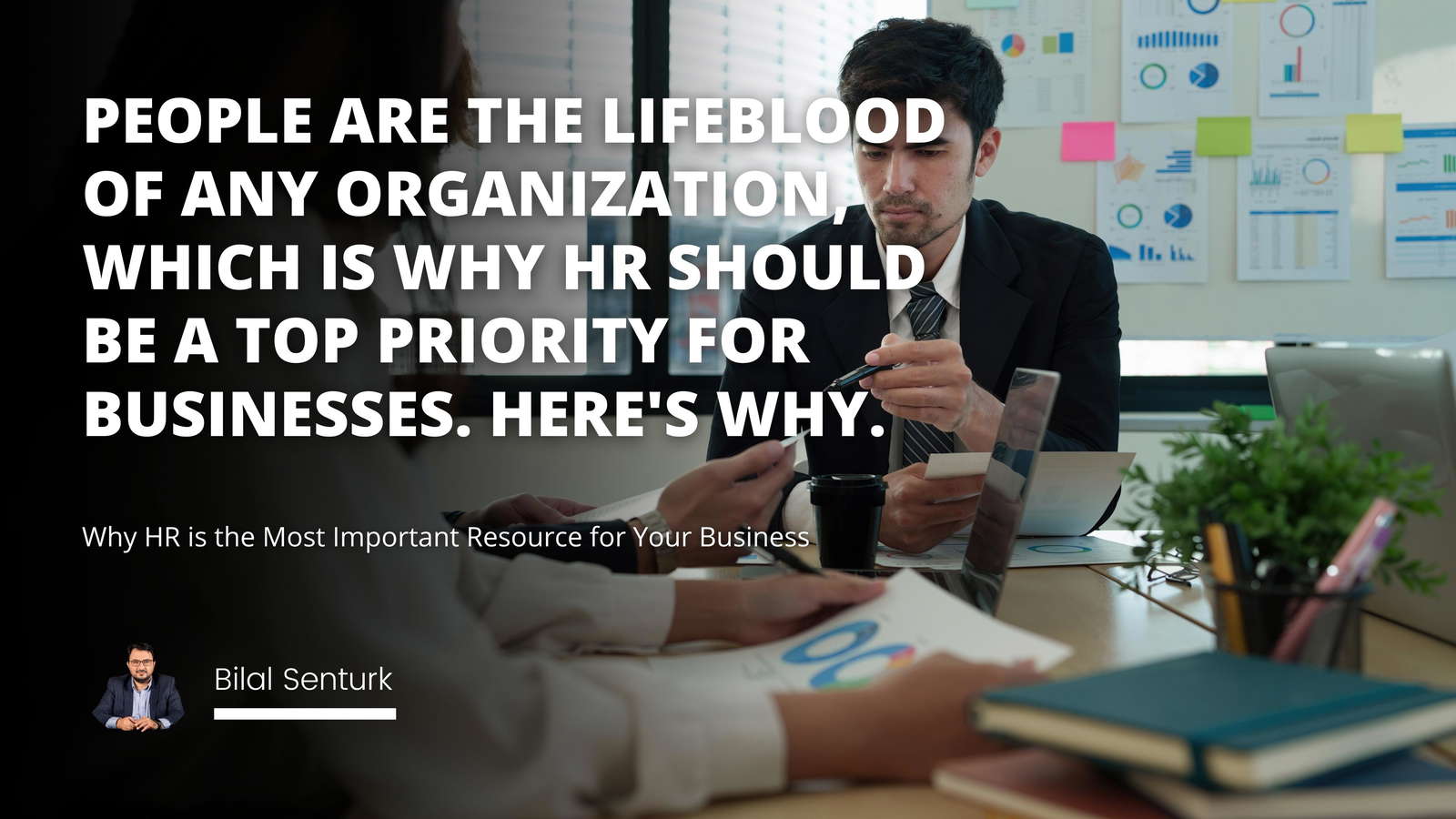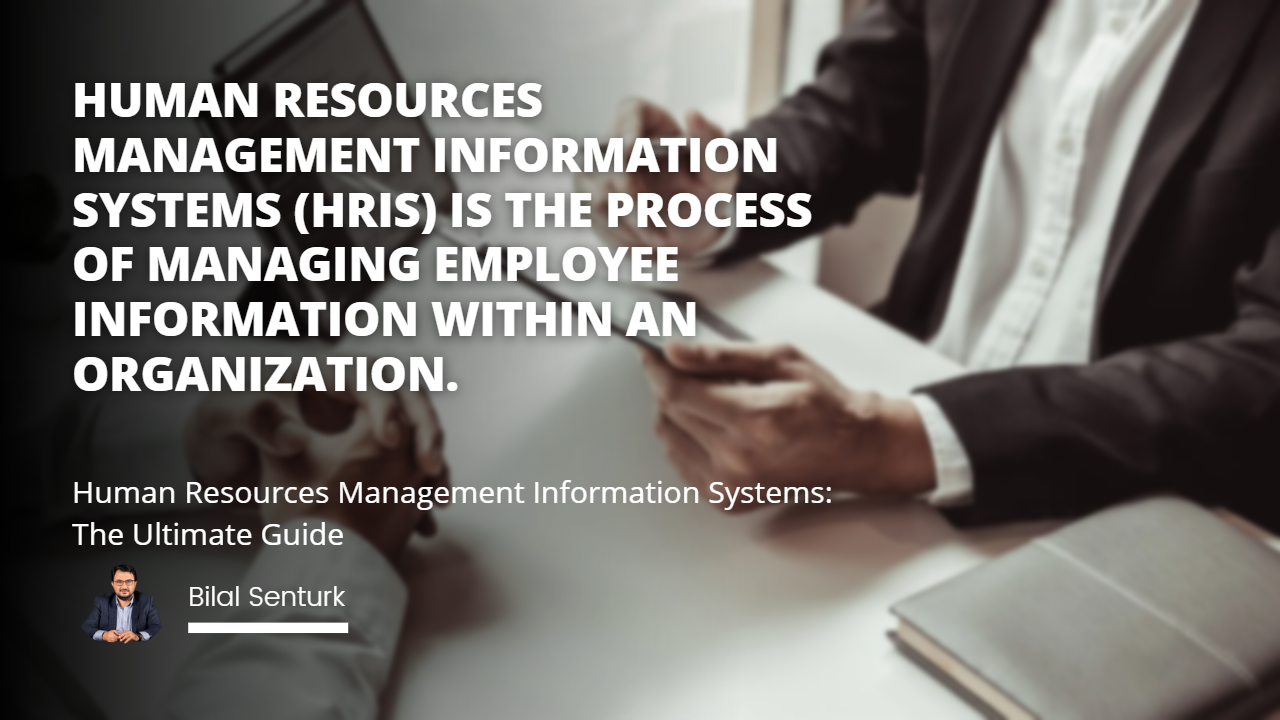
Understanding Talent Acquisition in Today's Market
In a world that's constantly evolving, securing the right talent has become a critical priority for industries across the globe. Finding and retaining talented employees isn't just about filling gaps; it's about strengthening the very foundation of a company to ensure longevity and success. The current talent-scarce market reflects a reality where the demand for skilled professionals surpasses the available supply, making competition fierce. This means that organizations need to be not just reactive but proactive in their hiring strategies.
Introduction
Overview of the Talent-Scarce Market
Benefits of Categorizing Hiring Process
The Four Categories of Human Resources Management
The Having
The Method to the Madness: Categorizing the Hiring Process
A widely discussed method that some of the most successful companies adopt involves categorizing the hiring process into four principal groups: The Having, The Getting, The Doing, and The Becoming. This structured approach helps in streamlining and targeting specific phases in the hiring lifecycle, ensuring not just acquisition, but also alignment with broader business goals.
1. The Having: Laying the Groundwork
Without a doubt, the first and perhaps most essential step in this structured process is clarity on what the organization needs - commonly known as "The Having." The phrase resonates with a personal experience I had during my early career days when my mentor stressed the primacy of outlining the job description. He emphasized it by saying, "Imagine you’re building a bridge – without proper blueprints, how would you ensure the structure stands?"
Key Functions Of Human Resource Management For Business Success
Mastering Behavioral İnterviews For Employers And Candidates
Defining the Role:
Detailing skills and competencies: Every job requires a distinct skill set; thus, pinpointing these from the outset is pivotal.
Experience and knowledge: It’s not just about having the right skills but also the right experiences that complement those skills.
Cultural fit: Beyond skills, understanding how a potential hire will fit into the company's current setup can prevent future discord.
Human Resources Job Description: Your Comprehensive Guide to HR Roles
Corporate HR: Designing Employee Compensation Benefits Packages
Through this phase, companies can prevent the costly mismatch of expectations that often leads to high turnover rates.
2. The Getting: Crafting an Enticing Proposition
Once you’ve laid out your needs, the next natural step is attracting the right candidates, or "The Getting." This step ties deeply into creating an offer that not only sounds appealing on paper but is genuinely beneficial for potential candidates. I remember once, in a seminar by renowned business consultant Jim addressed, he illustrated this beautifully using the analogy of fishing: "The quality of your bait determines the fish you catch."
Every company should:
Curate a compelling job title: It needs to be reflective of the role, yet captivating enough to pique interest.
Location, location, location: The place where the job is offered can be a significant draw — whether it’s a bustling urban center or a serene outpost.
Compensation deals: This isn't just about salary. In today’s age, benefits, flexibility, and growth prospects hold tremendous value.
When companies can effectively convey that they offer more than just a paycheck, they position themselves as not just an employer but a partner in a candidate's career journey.
Raising the Talent Bar is a process that requires four steps of Human Resources Management to be successful.
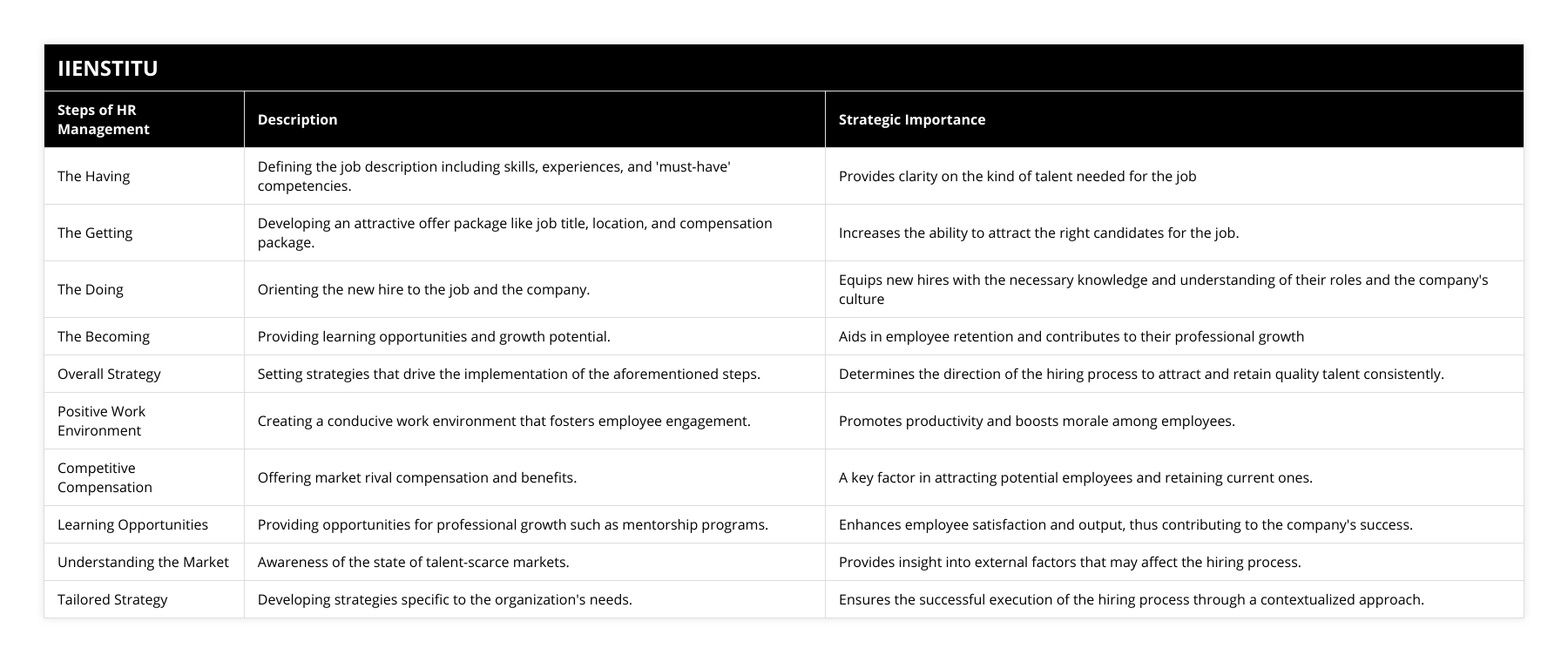
3. The Doing: Seamlessly Transitioning Talent
An offer accepted is only the beginning of a fruitful partnership. How a new hire integrates into their new role and the organization - termed "The Doing" - plays a make-or-break role in their career journey. Here’s a story from my own experience: In my first role, I was thrown directly into tasks without any orientation, and the transition was rocky. This underlines the importance of a structured onboarding process:
In-depth orientation programs: Educate new employees about company culture, goals, and their specific roles.
Mentorship initiatives: Assigning mentors can help new hires acclimate faster and establish valuable internal connections.
Feedback loops: Early feedback can help identify areas of improvement and serve as a guide for both the employee and the employer.
It’s about making them feel included, valued, and truly a part of the organization.
4. The Becoming: Building Future Leaders
When speaking of growth, "The Becoming" refers to ensuring continuous learning and positioning roles as springboards for future success. Growth potential is a critical consideration for many potential hires, with numerous surveys, including those conducted by HBR, emphasizing learning and advancement opportunities as primary motivators for job seekers.
Provide learning opportunities: Regularly updated training programs and an emphasis on internal promotions foster loyalty.
Leadership training: Preparing employees for future leadership roles ensures longevity and sustained excellence.
Growth pathways: Clearly outlined career progression paths can retain talent and motivate them to aim higher within the organization.
In understanding “The Becoming,” it’s important to contextualize it within the realm of personal development. On a personal note, during my tenure at a tech startup, opportunities for growth transformed not just my career but my outlook on work itself. It wasn't just a job, it was a journey.
Strategy Drives Tactics: A Roadmap for Success
Achieving the desired results of consistently attracting and hiring strong candidates isn't purely an operational process; it requires an overarching strategy. This is the essence of the "strategy drives tactics" methodology. A well-thought-out strategy acts as the north star amidst the complexity of corporate goals and market fluctuations. A strategic approach should focus on:
1- Developing attractive offer packages: Competitive salaries with significant non-monetary benefits.
2- Facilitating learning opportunities: Continuous skills development tailored to company needs.
3- Crafting a positive work environment: Prioritizing employee well-being and engagement.
Within these broad strokes, tactical actions operate at a granular level:
Employee engagement initiatives
Mentorship and coaching opportunities
Regular performance assessments with constructive feedback
This dual-layered approach ensures that hiring isn’t just a one-time event but an ongoing alignment with broader organizational goals.
Conclusion: A Path Towards Excellence
In redefining the talent acquisition process, categorizing the hiring journey into these well-thought-out steps offers organizations an invaluable pathway to success. Employing the "strategy drives tactics" approach ensures alignment between the company's broader goals and specific hiring practices. This not only benefits businesses but enhances individual careers, embodying the organizational values of growth, opportunity, and inclusion.
Through revealing personal narratives and experiences, we see the transformative power of a structured hiring approach. It isn't just about filling positions, but about creating lasting relationships, echoing a journey of mutual growth and sustained success.
References
1- Smith, J. (2015). Talent Management: Making it work in your organization. Pearson Education.
2- Johnson, K. (2019). The Power of Corporate Strategy: Bridging the gap between workers and management. Harper Business.
3- Rogers, A. (2018). Onboarding Essentials: Building a productive workplace culture. McGraw-Hill.
4- Lewis, T. (2020). Cultural Fit and Leadership: A modern approach to management. Routledge.
Here, by grounding our discussion in personal stories, research, and proven strategies, we not only illuminate the pathway for companies but create a relatable, authentic narrative for individuals on both sides of the hiring table.
Frequently Asked Questions
What are the key factors that contribute to climate change?
Key Factors Contributing to Climate Change
There are several key factors that contribute significantly to climate change. The most significant is the burning of fossil fuels such as coal, oil and natural gas. When fossil fuels are burned, they release greenhouse gases like carbon dioxide and methane into the atmosphere. These greenhouse gases trap heat from the sun, causing global temperatures to rise.
Deforestation is another major factor. Trees absorb and store carbon dioxide. When forests are cleared, that stored carbon is released. Deforestation also reduces the number of trees available to remove carbon dioxide from the air. Between 2015 and 2020, the world lost over 4 million hectares of forest per year.
Intensive livestock farming generates significant greenhouse gas emissions. Cows and sheep produce methane as part of their digestive process. Large scale cattle ranching leads to deforestation too. The livestock sector accounts for around 15% of global emissions.
Other contributors are fertilizers containing nitrogen and the burning of biomass. Overall, human activities are responsible for almost all of the increase in greenhouse gases over the last century. To mitigate climate change, we must transition from fossil fuels to renewable energy and prevent further deforestation. We must also reduce emissions from agriculture and other sources.
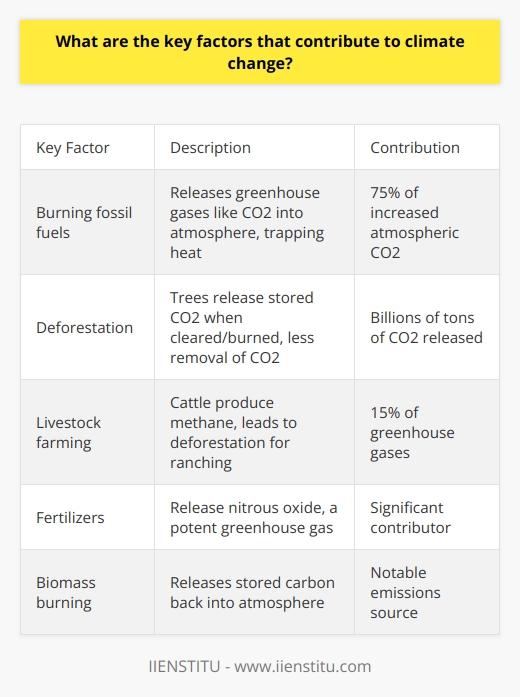
How does gender inequality manifest in different cultures?
Manifestations of Gender Inequality
Gender inequality refers to unequal treatment or perceptions of individuals based on their gender. This manifests in various ways across cultures. In many cultures, traditional gender roles cast women as caregivers and men as leaders. This leads to inequalities in domestic duties, employment, and positions of authority. For example, in parts of South Asia, women spend much more time on unpaid domestic work than men. In Saudi Arabia, strict laws prohibit women from traveling or working without a male guardian's permission.
Gender discrimination in education also perpetuates inequality. In Afghanistan, girls face barriers to attending school including lack of facilities, child marriage, and Taliban restrictions. Only 37% of Afghan girls complete primary education, compared to 66% of boys. This lack of education limits women's ability to participate in society.
Violence against women is another manifestation of gender inequality. Practices like female genital mutilation in parts of Africa, acid attacks in Southeast Asia, and honor killings in the Middle East target and control women. Up to 38% of murders of women worldwide are committed by intimate partners. Laws and enforcement often fail to protect women.
While many cultures have embedded gender inequalities, increased education for women and girls, activism, and legal protections are working to promote equal rights. Achieving gender equality requires changing long-held biases and practices.
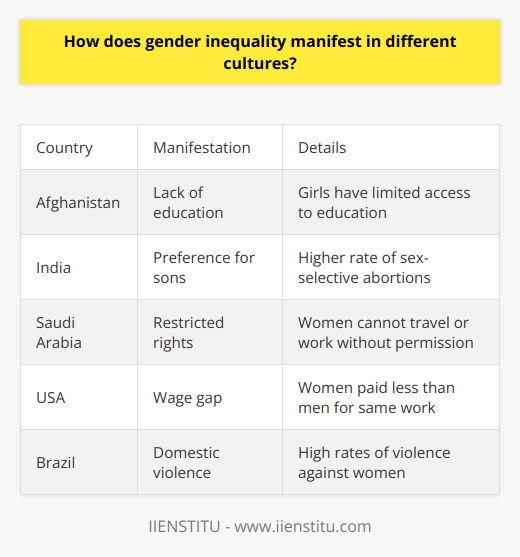
What policies can governments implement to reduce poverty?
Policies to Reduce Poverty
Governments can implement several policies to help reduce poverty. One important policy is to increase access to education. Governments can make primary and secondary education free and compulsory. They can also provide subsidies and scholarships to help low-income students attend college or vocational schools. Education gives people the skills needed to obtain better-paying jobs.
Another policy is to create more jobs and improve wages. Governments can invest in infrastructure and green technology to create construction and manufacturing jobs. They can set higher minimum wages and strengthen unions to improve pay. Policies that support small businesses can also lead to more job creation.
Governments can also strengthen social safety net programs. They can provide cash assistance, food stamps, and housing vouchers to help families meet their basic needs. Healthcare subsidies can make insurance more affordable. Increasing funding for childcare, disability, and unemployment benefits further aids those struggling financially.
Lastly, governments can reform tax policies to ease the burden on lower-income households. They can make tax systems more progressive by increasing taxes on the wealthy. Tax credits like the Earned Income Tax Credit can supplement wages for workers. Reducing regressive payroll and sales taxes helps increase take-home pay.
Implementing a mix of education, job creation, safety net, and tax reform policies can significantly reduce poverty. A comprehensive approach addresses both the symptoms and root causes of financial hardship for low-income families and individuals.
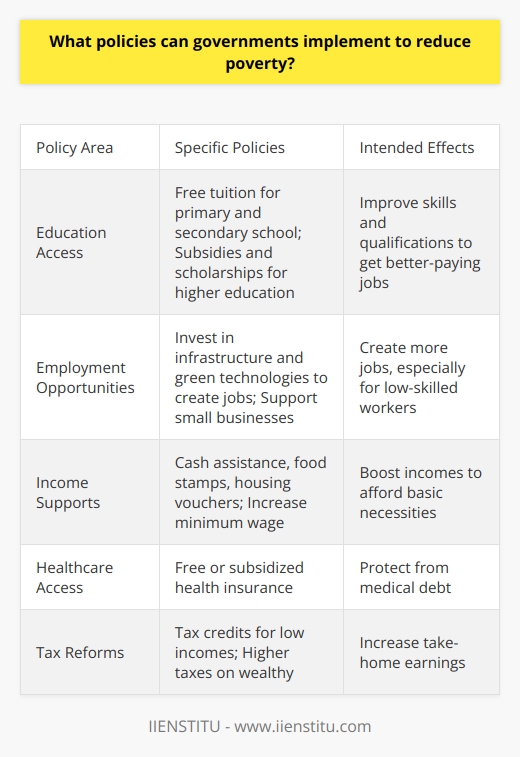
What are the 4 steps of human resources management for raising the talent bar?
Attracting Talent<br>The first step in raising the talent bar is attracting highly skilled and qualified candidates to apply for open positions. This involves developing a strong employer brand and reputation, offering competitive compensation and benefits, highlighting development opportunities, and building talent pipelines through internships and university recruiting. Effective sourcing strategies like employee referrals and social media outreach are also key.
Selecting Talent<br>Once talent is attracted, the next step is selecting the best candidates through rigorous screening and assessment. This includes conducting structured interviews, administering tests to assess skills and cognitive abilities, checking references, and requiring writing samples or portfolios. Selection should focus on both technical capabilities and cultural fit. The goal is to hire candidates with the highest potential to succeed.
Developing Talent<br> After top talent is hired, the third step is developing skills and leadership capabilities through training, coaching, and experiences like stretch assignments and rotations. Development planning should align individual goals with organizational needs. On-the-job learning, mentoring programs, and tuition assistance are key. The aim is to nurture talent and build the workforce.
Retaining Talent<br>The final step is retaining top talent by promoting engagement, recognition, work-life balance, and advancement opportunities. Flexible work arrangements, career paths, compensation incentives, and succession planning help retain workers. Tracking retention metrics and conducting exit interviews provide insight. The ultimate goal is sustaining a high-performing workforce.

How can human resources management raise the talent bar through its 4 steps?
Attracting Talent<br>The first step human resources can take to raise the talent bar is to improve their strategies for attracting top talent. This involves identifying the best sources for qualified candidates such as employee referrals, social media, and niche job boards. Creating an employer brand that highlights the organization's values and culture is also key to attracting candidates that are a good fit. The recruitment process should be candidate-focused, providing a positive experience even for those not selected.
Selecting Talent<br> Once talent is attracted, the next step is selecting the right people to hire. Human resources should use evidence-based selection methods like structured interviews, work samples, and skills testing rather than relying solely on resumes. Interview questions should be designed to assess not just experience but also competencies and cultural fit. Multiple qualified interviewers should be used to reduce bias. Selection should focus on both current job needs and future potential within the organization.
Developing Talent<br>After making great hires, human resources needs to focus on developing talent. This includes onboarding programs to successfully integrate new hires. Mentoring programs and clear career paths should promote growth within the organization. Ongoing training and development opportunities allow employees to gain new skills. Regular performance reviews identify areas for improvement while allowing employees to provide feedback. Surveys can also assess engagement and opportunities for advancement.
Retaining Talent<br> The final step is implementing strategies to retain top talent long-term. Human resources should advocate for competitive compensation and benefits. Flexible work arrangements promote work-life balance. Employee recognition programs validate contributions. Analyzing turnover metrics identifies risk factors. Succession planning creates pipelines for advancement. By focusing on retention, human resources reduces costly turnover of high performers.
In summary, human resources management can systematically raise the talent bar by improving how they attract, select, develop, and retain talent. Using evidence-based practices at each step allows organizations to build a skilled, engaged workforce and gain a competitive advantage.
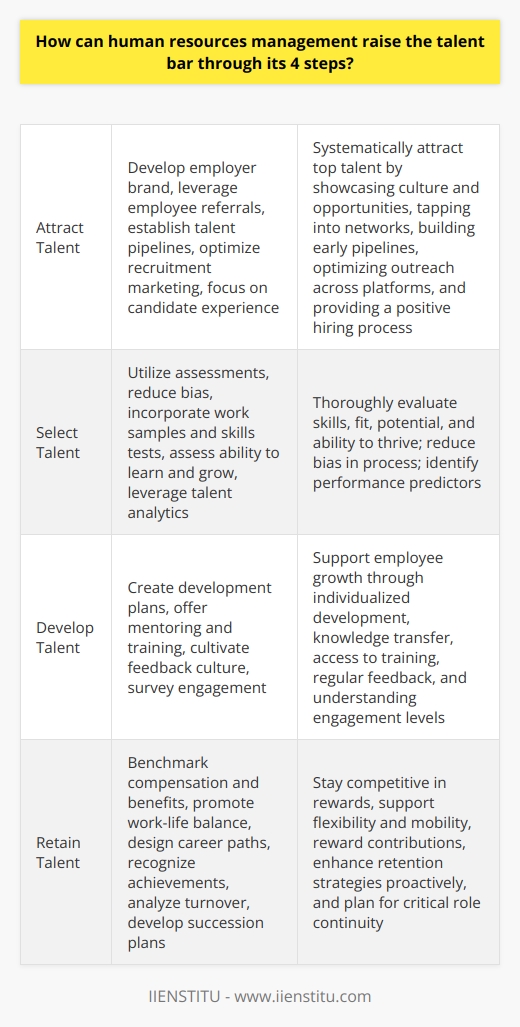
In an interview, what would you say are the 4 steps of human resources management for raising the talent bar?
Attracting Talent
Selecting Talent
Developing Talent
Retaining Talent

What are some of the key insights from the McKinsey talent management PDF?
Attracting and Retaining Top Talent
The McKinsey report on talent management provides several key insights for organizations looking to attract and retain top talent. One major takeaway is that top performers are not motivated solely by compensation. While compensation is important, top talent also values working on challenging assignments, having opportunities for advancement, and being part of an inspiring culture. As such, organizations need to focus on creating an engaging employee value proposition that goes beyond financial rewards.
Another key insight is that hiring processes need to be rigorous and selective. McKinsey found that high-performing companies have more stringent requirements for hiring. They invest significant time and effort in evaluating candidates to find those who best fit the role and culture. Maintaining high hiring standards is essential for bringing in top talent.
The report also emphasizes the importance of people analytics in managing talent. Leading companies are using data and advanced analytics to gain insights into their workforce. This enables more informed decision-making on areas like rewards, development, retention and succession planning. Adopting a data-driven approach allows organizations to target interventions towards top talent more precisely.
Lastly, McKinsey highlights that talent management should be a priority for senior leaders. High-performing companies have executives and managers who are actively engaged in attracting, developing and retaining top talent. Leaders must champion talent management practices and serve as role models for desired mindsets and behaviors. This top-down commitment to ongoing talent management is vital for success.
In summary, the McKinsey research reveals that managing talent effectively requires a multifaceted strategy focused on enriching the employee value proposition, upgrading hiring standards, leveraging analytics, and securing leadership commitment. With deliberate efforts on these fronts, companies can build a high-quality workforce that drives performance.
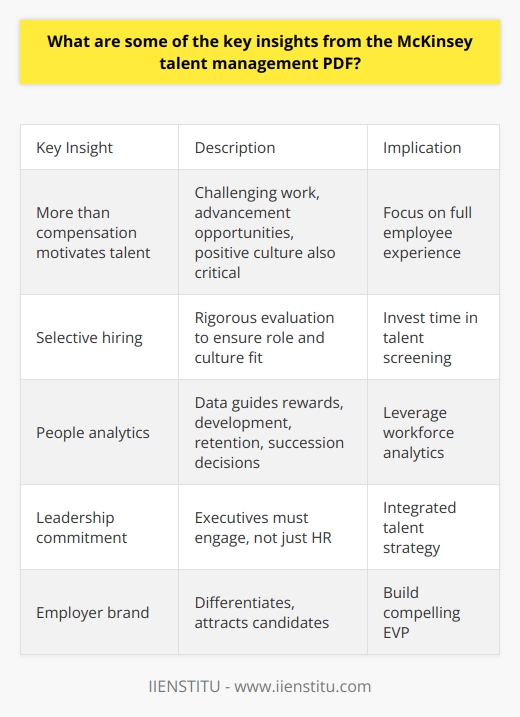
How can the principles from the McKinsey talent management PDF be applied in practice?
Applying McKinsey's Talent Management Principles
The McKinsey talent management principles provide a framework for organizations to optimize their approach to managing talent. There are several ways these principles can be applied in practice.
Strategic Workforce Planning
Organizations should forecast future talent needs and develop a strategic workforce plan aligned to business objectives. This involves analyzing workforce supply and demand, identifying talent gaps, and creating initiatives to build, buy, borrow, and bridge talent. Succession planning for critical roles is also key.
Data-Driven Decision Making
HR analytics should be leveraged to inform talent decisions. Useful metrics include workforce demographics, retention rates, hiring sources, performance ratings, engagement scores, and promotion velocity. Advanced analytics can identify predictors of high performance and retention risk.
Differentiated Capability Building
Targeted development initiatives should be created for high potentials, critical skill roles, and poor performers. High potentials benefit from stretch assignments, mentoring, and leadership programs. Upskilling helps close critical skill gaps. Poor performers need performance management support.
Inclusive, Flexible Work Practices
Organizations should nurture an inclusive culture where all employees can thrive. Flexible work policies help attract and retain diverse talent. Ergonomic workspaces, remote work options, flexible hours, and parental leave signal a commitment to work-life balance.
Total Rewards Optimization
The total rewards program should be regularly evaluated for alignment, competitiveness, and effectiveness. Compensation, benefits, perks, recognition, career development, and culture all factor into the employment value proposition. Rewards should be differentiated based on performance and potential.
Applying McKinsey's principles requires a strategic, analytics-driven approach to talent management. The focus should be on workforce planning, capability building, inclusive and flexible work practices, and optimizing total rewards. This creates an engaging employee experience that fuels business performance.

What are the limitations of the approach outlined in the McKinsey talent management PDF?
Limitations of McKinsey's Talent Management Approach
McKinsey's approach to talent management, as outlined in their PDF report, has several notable limitations. One major limitation is the narrow focus on identifying and developing high-potential employees, rather than adopting a more inclusive approach to developing all employees. This exclusive focus risks disengaging average performers. It also relies heavily on subjective assessments of potential, which can introduce bias.
Narrow Focus on High-Potentials
By concentrating talent management efforts on high-potentials, organizations miss opportunities to improve performance across the broader employee base. Average performers have less access to development opportunities under this approach. This can decrease engagement, increase turnover, and limit organizational capability. An inclusive approach that provides development opportunities for all employees is more likely to realize the full potential of the workforce.
Subjective Assessments of Potential
McKinsey's approach depends heavily on subjective assessments of employee potential. However, research shows that performance ratings and promotion decisions often involve unconscious biases. Managers may underestimate the potential of certain groups based on gender, race, age or other factors. Relying on subjective assessments introduces the risk that talent management programs will reflect and amplify these biases rather than objectively identify top talent.
In summary, the exclusive focus on high-potentials and reliance on subjective assessments are two notable limitations of McKinsey's proposed talent management approach. A more inclusive strategy and objective identification methods could improve workforce development and avoid biased outcomes. Further research is needed to design talent management programs that realize the full potential of all employees.
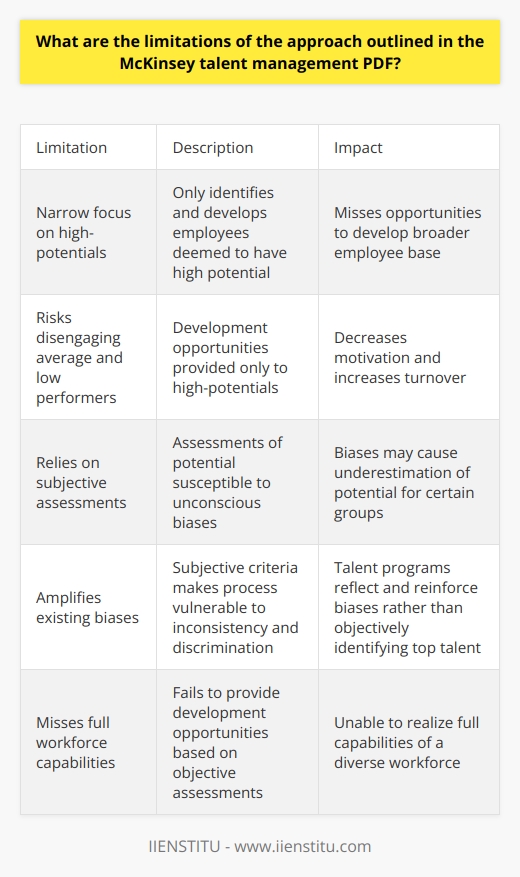
What are the key components of an effective talent management strategy plan?
An effective talent management strategy plan requires several key components in order to successfully attract, develop, and retain top talent within an organization. The most critical elements include having a clear understanding of current and future talent needs, implementing programs for recruitment and onboarding, providing development and training opportunities, offering competitive compensation and benefits, promoting employee engagement and retention, and utilizing technology and metrics to track progress.
Understanding Talent Needs
Organizations must forecast the talent that will be required both currently and in the future to meet business objectives. This involves assessing the existing workforce and anticipated turnover, as well as growth plans and pending retirements. By pinpointing talent gaps, the talent strategy can be tailored to fill critical roles.
Recruitment and Onboarding
With talent needs identified, targeted recruitment utilizing modern sourcing strategies enables firms to reach qualified candidates proactively. Clear employer branding conveys what makes the organization an attractive workplace. Effective onboarding then rapidly integrates new hires through training on culture, systems, and processes.
Development and Training
Ongoing development opportunities aid in employee retention and progression. Training programs specific to roles, leadership, and technical skills build talent. Mentoring and coaching also promote growth. Supporting continuing education demonstrates investment in staff.
Compensation and Benefits
Competitive and fair compensation and benefits that reward strong performance attract and retain top talent. Salaries and incentive pay aligned to market rates demonstrate valuation of contributions. Comprehensive benefits including health insurance, retirement plans, and paid time off provide security.
Employee Engagement and Retention
Engaged, satisfied employees are less likely to leave. Fostering a positive, supportive company culture boosts morale. Opportunities for career development, work-life balance, and employee recognition programs also drive retention. Stay interviews help identify engagement issues.
Technology and Metrics
HR technology streamlines cumbersome processes, provides valuable workforce analytics, and enables remote work arrangements. Key talent metrics such as turnover rate, time-to-fill, and cost-per-hire should be tracked to evaluate strategy effectiveness. Goals and benchmarks maintain focus on optimal outcomes.
By focusing on these core elements, organizations can build an integrated talent management strategy plan that secures a high-quality, engaged workforce able to drive business success both now and in the future.
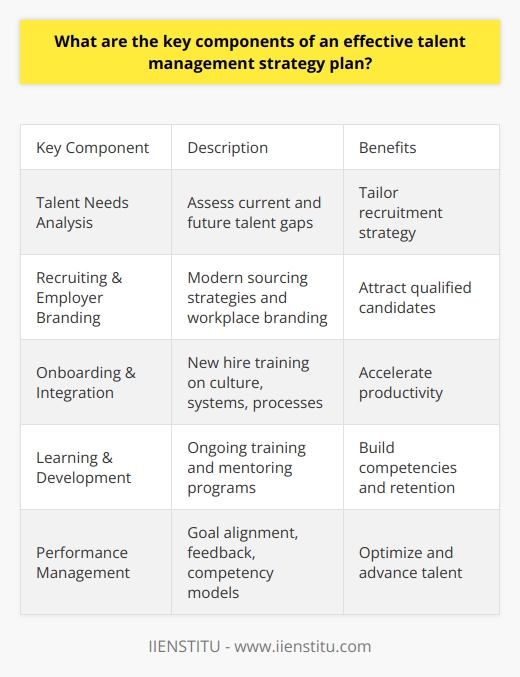
How can organizations align their talent management strategy plan with broader business goals?
Aligning Talent Management and Business Strategy
Organizations can align their talent management strategy with broader business goals in several key ways. First, they must ensure tight integration between their business and talent strategy. The talent strategy should directly support overarching business goals and objectives. For example, if the business aims to expand into new markets, the talent strategy may focus on recruiting employees with relevant language skills or cultural experience. Likewise, if the business wants to release a new product line, the talent plan can prioritize upskilling and training for staff in those competency areas.
Second, organizations should optimize their talent acquisition and development initiatives to build the workforce capabilities needed for the future. This involves workforce planning to forecast talent gaps based on business strategy. Recruitment, training, leadership development and other talent programs can then be tailored to build a pipeline of talent that enables business goals. For instance, leadership training may focus on change management skills to support an organizational transformation initiative.
Third, performance management processes should align individual goals with business objectives. By cascading top-level goals down throughout the organization, employees at all levels can see how their work contributes to strategic outcomes. This enhances line of sight and helps focus talent efforts on what matters most for the business. Organizations can reinforce this through goal-setting, regular check-ins, and tying performance evaluations to business results.
Fourth, compensation and rewards should incentivize behaviors that support the business strategy. Pay structures, bonuses, and other incentives can be designed to motivate employees to achieve key business goals. For example, sales compensation plans with SPIFFs can drive growth in strategic product lines. Likewise, enterprise-wide bonus plans based on company profitability can unite all employees behind growth goals.
Fifth, the talent management technology strategy should provide the data and analytics needed to support strategic decision-making. Robust HRIS systems with integrated reporting allow leaders to analyze workforce trends, project future talent needs, and make data-driven decisions to optimize human capital for the business. The technology roadmap should be aligned with strategic talent and business priorities.
In summary, organizations must tightly integrate their talent and business strategies, optimize talent programs for strategic capabilities, cascade goals and incentives, and invest in supporting technologies. This fosters a workforce focused on achieving the organization's most important business objectives.
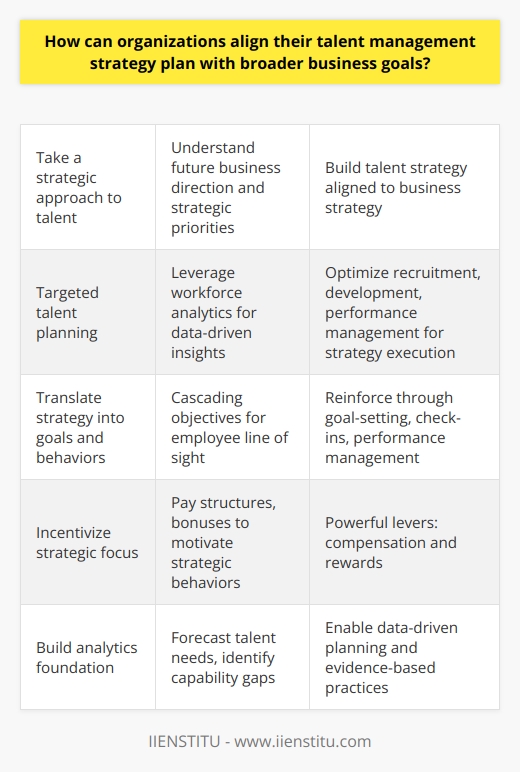
What steps can HR leaders take to gain buy-in for a new talent management strategy plan?
Gaining Buy-in for New Talent Management Strategies
Human resources (HR) leaders can take several steps to gain buy-in for new talent management strategy plans from stakeholders. First, they should clearly communicate the need for change. HR leaders need to explain why current strategies are not working optimally and how new approaches will lead to better outcomes like improved talent recruitment, development, and retention. They can present data showing deficiencies in existing strategies. Illustrating the problems gets stakeholders to recognize the need for change.
Next, HR leaders need to involve stakeholders in the strategy development process. By getting input and feedback from stakeholders like executives, managers, and employees, HR ensures the new strategies reflect stakeholder needs and interests. Collaborative development gets stakeholders invested in creating and implementing the strategies. Their involvement leads to greater buy-in. HR should communicate regularly with stakeholders throughout the strategy planning process.
HR leaders also need to connect the talent management strategies to broader organizational objectives. They should explain how the strategies will help the organization achieve critical goals around growth, innovation, productivity, etc. Linking talent management to organizational success demonstrates its importance. This helps gain stakeholder commitment to supporting the strategy.
Additionally, HR needs to highlight the benefits of the new talent management approaches. They should show stakeholders how the strategies will positively impact talent capabilities that drive performance and results. Communicating the value proposition of the new strategies gets stakeholders to see their advantages. HR leaders need to tailor communications to address different stakeholder interests and priorities.
Finally, HR should develop robust change management and communication plans. They need to promote awareness and understanding of the new strategies across the organization. Training programs, workshops, and online resources can educate stakeholders. Celebrating small wins helps reinforce the value of the strategies. Ongoing communication and troubleshooting during implementation maintains buy-in.
In summary, HR leaders can gain buy-in for new talent management strategies by communicating the need for change, involving stakeholders, connecting to organizational goals, highlighting benefits, and managing the change process. Taking these steps will lead to greater stakeholder acceptance and support.
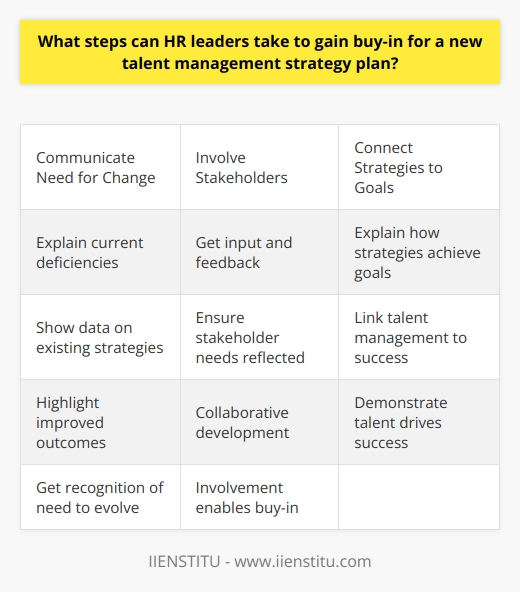
What are some best practices for developing talent within an organization?
Developing talent within an organization is crucial for long-term success. There are several best practices organizations can follow to effectively develop their talent. This includes providing training and development opportunities, creating individual development plans, offering mentoring and coaching, promoting from within, and fostering a learning culture.
Training and Development Opportunities
Organizations should provide training and development opportunities to help employees build new skills. This can include formal training programs, workshops, conferences, online courses, tuition reimbursement for advanced degrees, and more. Training helps employees stay up-to-date on the latest industry practices and advance their careers.
Individual Development Plans
Organizations should work with employees to create individual development plans that outline goals and development opportunities. This collaborative process identifies strengths employees can leverage and areas for growth. The plan acts as a roadmap for building skills through various development activities.
Mentoring and Coaching
Pairing less experienced employees with mentors and coaches provides guidance and support. Mentoring relationships and coaching sessions help mentees set goals, develop competencies, and prepare for advancement. This facilitates sharing knowledge between experienced and less experienced employees.
Promoting from Within
Promoting talented employees from within signals a commitment to developing talent. It also boosts engagement and retention by rewarding strong performers with advancement opportunities. Internal promotions encourage aspiration and demonstrate that hard work can lead to career growth.
Fostering a Learning Culture
Organizations should strive to create a culture of continuous learning, innovation, and growth. This means encouraging employees at all levels to develop new capabilities, experiment with ideas, and see mistakes as opportunities to improve. Fostering this supportive mindset empowers employees to take charge of their development.
In summary, developing talent requires providing training, individualized development plans, mentoring, internal promotion opportunities, and an overall learning culture. With these best practices, organizations can effectively nurture skills, motivate employees, and retain top talent.
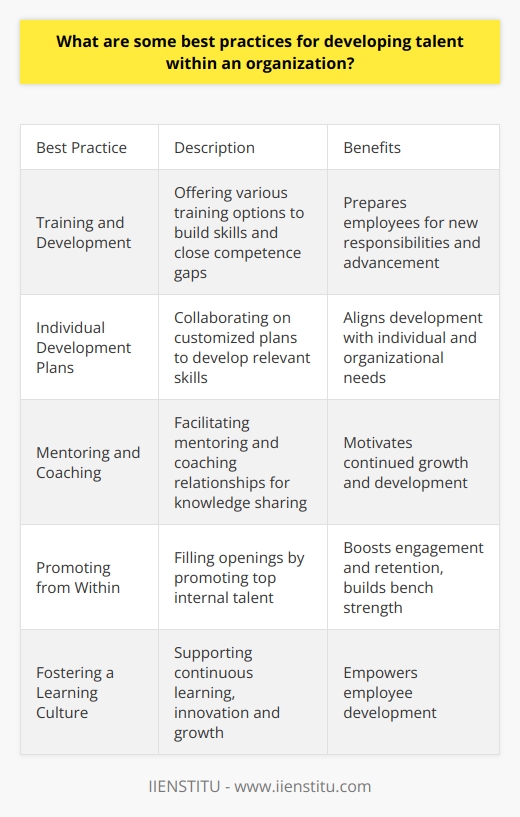
How can HR departments attract and retain top talent?
Attracting Top Talent
HR departments can attract top talent by offering competitive compensation packages. Research shows pay is a top factor for job seekers. HR should benchmark pay against industry standards. Bonuses, stock options, and profit sharing also entice top performers. Beyond pay, having a strong employer brand attracts talent. HR builds an employer brand through social media, recruitment marketing, and public relations. Highlighting company culture, values, and mission resonates with top talent. Emphasizing training, development, and career growth opportunities is equally key. Workplace flexibility and remote work options appeal to many professionals today. Providing generous vacation time and sabbaticals shows a commitment to work-life balance.
Retaining Top Talent
Once hired, HR must focus on retaining top talent. Offering clear career paths with regular promotions is important. Providing training and development builds employee skills. Coaching and mentoring programs create engagement and loyalty. HR should conduct regular performance reviews with feedback. This enables employees to grow. Recognizing and rewarding top talent is also key. Awards, bonuses and spot rewards show appreciation. HR should measure employee satisfaction through surveys. Addressing concerns quickly improves retention. Encouraging work-life balance and flexibility prevents burnout. Top performers should have input into decision making. This makes them feel valued. No talent management strategy is complete without succession planning. This gives top employees a reason to stay long term.
Conclusion
Attracting and retaining top talent requires a multipronged approach by HR. Offering competitive compensation, strong employer branding and development opportunities attracts top talent. Retention results from clear career paths, training, recognition, work-life balance and succession planning. With strategic talent management, HR helps build a high-performing workforce.
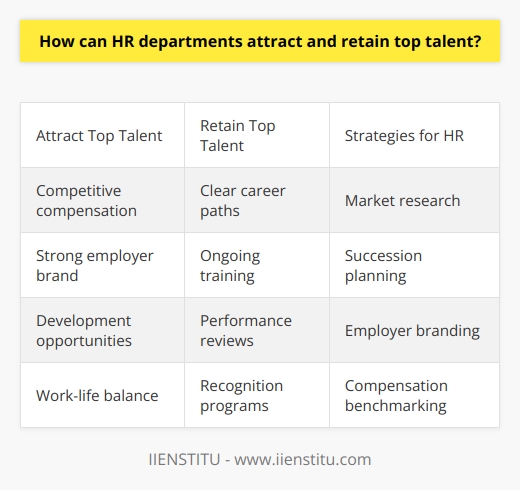
What skills are most important when managing people and HR processes?
The most important skills for managing people and HR processes effectively are communication, organization, leadership, and relationship building. Clear and open communication is key to ensuring employees understand their roles, responsibilities, and expectations. Organizational abilities help managers develop efficient systems, processes, and procedures. Strong leadership skills are necessary to motivate teams, provide direction, and drive results. Finally, relationship building allows managers to understand their employees' needs, foster collaboration, and resolve conflicts.
Communication involves both speaking and listening. Managers must clearly convey goals, provide feedback, and explain policies and procedures. They need active listening skills to understand employees' concerns. Effective written communication is also important for emails, memos, and reports. Communication keeps everyone aligned and engaged.
Organization is critical when managing teams and overseeing HR functions like recruiting and onboarding. Managers should have planning and time management skills to set priorities and schedules. They need organizational abilities to implement efficient workflows, processes, and filing systems. Organization helps maximize productivity.
Leadership abilities enable managers to inspire teams to achieve goals. Key leadership skills include motivating employees, supporting professional growth, and empowering workers. Leaders also model desired behaviors. They think strategically to establish vision and direction. Strong leadership unifies teams behind objectives.
Relationship building fosters trust between managers and employees. It involves being approachable and taking interest in workers' lives. Understanding personality types and work styles helps managers collaborate effectively. They resolve conflicts through empathy, diplomacy, and consideration of diverse viewpoints. Solid relationships create cohesive, supportive teams.
In summary, communication, organization, leadership, and relationship building are essential for managing people and HR functions. Managers who excel in these areas can create positive, engaged workplaces where employees thrive and organizations see results.
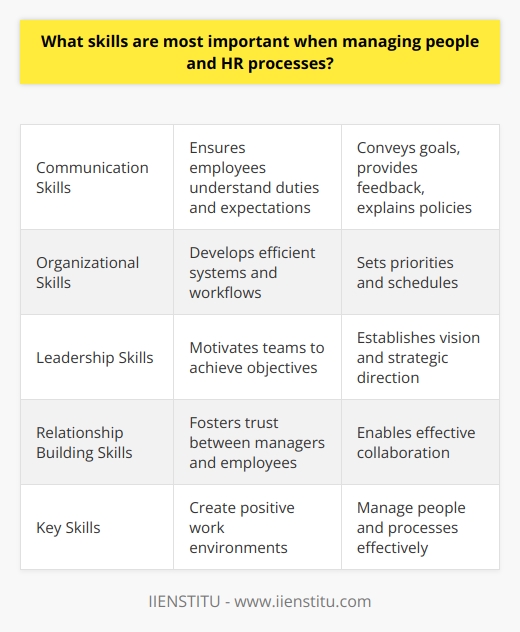
What strategies can organizations use for effective talent planning?
Talent planning is a crucial process for organizations to ensure they have the right people with the right skills available at the right time. There are several strategies organizations can use for effective talent planning.
Conduct workforce analysis
Organizations need to analyze their current workforce to identify talent surpluses and gaps. This involves assessing employee skills, performance, aspirations, and expected turnover. Workforce analysis enables organizations to anticipate future talent needs based on business goals and projected growth.
Forecast talent needs
Forecasting future talent requirements allows organizations to plan ahead. Common methods include ratio analysis of employees to output, replacement charts showing expected turnover, and skills inventories highlighting capabilities needed for future plans. Forecasting identifies the talent organizations will require in the short, medium and long term.
Develop talent pools
Organizations can develop talent pools to build a supply of qualified candidates. This involves identifying high potential employees and critical roles, then providing development opportunities. Rotation programs, training, mentoring and stretch assignments help create a robust talent pipeline.
Optimize recruitment
Aligning recruitment to forecast talent needs ensures organizations attract suitable candidates proactively. Recruitment optimization involves sourcing talent effectively, enhancing the employer brand, and improving hiring processes. It also requires coordination between recruitment and other HR functions.
Retain top talent
Retaining top talent is crucial for meeting current and future capability requirements. Strategies include competitive compensation, engaging work, development opportunities, recognition programs and work-life balance initiatives. Effective retention reduces turnover costs and maintains organizational knowledge.
In summary, organizations can optimize talent planning through workforce analysis, forecasting, talent pool development, aligned recruitment and talent retention. Taking a strategic approach allows organizations to build capabilities and agility to achieve business objectives.
How can organizations identify and develop high potential employees through talent planning?
Identifying High PotentialsOrganizations can identify high potential employees by using assessments and reviews to evaluate performance, skills, and competencies. Assessments such as 360-degree feedback, skills testing, and personality inventories provide insight into strengths, development areas, and leadership capabilities. Performance reviews, when structured appropriately, reveal top performers with growth ability. Competency models aligned to business strategy allow organizations to pinpoint competencies that predict success. By analyzing assessment and review data, organizations can create a talent pipeline and succession plans for critical roles.
Developing High PotentialsOnce identified, organizations can develop high potential employees through stretch assignments, coaching, mentoring, and training programs. Stretch assignments give exposure to diverse roles, teams, and challenges. They test readiness for advancement while building capabilities. Coaching and mentoring relationships, especially from senior leaders, provide feedback, visibility, counseling, and sponsorship. Formal leadership development programs offer targeted learning for high potentials. Curriculum may include business acumen, strategy, leading change, innovation, presentation skills, and other areas. Training helps strengthen competency gaps and interpersonal abilities. Ongoing development of high potentials boosts engagement, retention, and performance.
Succession Planning Succession planning is a key talent strategy for leveraging high potentials. Organizations can build pipelines by mapping critical roles, identifying successors, and readying them through development plans. This ensures a steady talent supply as leaders retire or pursue other opportunities. Effective succession planning is vital for knowledge transfer and continuity in mission-critical positions. It also gives high potentials a clear career path and goals. Organizations should integrate their approaches to identifying, developing, and advancing top talent. A holistic talent planning strategy allows organizations to get the most value from high potential employees.
What are some best practices for aligning talent planning with overall business strategy?
Aligning Talent Planning with Business Strategy
There are several best practices that organizations can follow to effectively align their talent planning with their overall business strategy. First, it is critical that HR and business leaders collaborate closely to understand the organization's strategic priorities and what talent will be needed to execute on those priorities. This may involve creating cross-functional teams or committees with representatives from HR, finance, operations, and other business units to forecast talent needs.
Second, organizations should take a data-driven approach to talent planning. By analyzing workforce demographics, utilization rates, turnover trends, and performance metrics, HR can identify current and future talent gaps that may impede strategy execution. Analytics enable evidence-based decision making in talent acquisition, development, and retention.
Another best practice is to integrate strategic workforce planning into the broader annual strategy planning process. The talent strategy should directly link back to corporate objectives around growth, innovation, efficiency etc. Workforce plans may need to be adjusted as the business strategy pivots.
Additionally, companies should identify pivotal roles that have an outsized impact on strategic success and develop robust succession plans for those roles. There should be multiple potential successors ready to step in, supported by leadership development programs.
Finally, strategic talent planning requires buy-in and participation from business unit leaders in addition to HR. Line managers must be accountable for developing and retaining high-potential talent within their teams. A collaborative process where leaders across the business have input will result in an actionable talent strategy tightly aligned to business objectives.
What is the definition of talent management according to SHRM?
Introduction
Talent management has become an increasingly important topic in human resource management and organizational development. As organizations seek to gain competitive advantage, there is a growing recognition that talent is a key source of value creation. This has led to an emphasis on more strategic approaches to managing talent. A leading voice in articulating and shaping talent management practices is the Society for Human Resource Management (SHRM).
SHRM's Definition of Talent Management
According to SHRM, talent management refers to the "implementation of integrated strategies or systems designed to increase workplace productivity by developing improved processes for attracting, developing, retaining and utilizing people with the required skills and aptitude to meet current and future business needs." This definition highlights some key components of talent management:
Firstly, it emphasizes the need for integrated strategies and systems. Effective talent management requires a holistic approach that connects various HR processes like recruitment, learning and development, performance management and succession planning. Secondly, the definition focuses on enhancing workforce productivity as the overall goal. The talent management strategies aim to nurture a skilled, engaged and high performing workforce. Thirdly, it entails attracting, developing, retaining and effectively utilizing talent. All aspects of the employee lifecycle are important in building and leveraging talent.Finally, there is an emphasis on aligning talent management with business strategy. The goal is to have the right people with the right skills to drive organizational success now and in the future.
Conclusion
In summary, SHRM's perspective highlights that talent management requires a strategic and holistic approach to maximize workforce productivity and organizational performance through effective management of talent resources. It is a key human capital process that enables execution of business strategy.
What are the key components of talent management according to SHRM?
Talent management is a crucial process for organizations to recruit, develop, and retain top talent. According to the Society for Human Resource Management (SHRM), there are several key components that comprise an effective talent management program.
Workforce PlanningWorkforce planning involves forecasting labor supply and demand to identify critical talent needs for the future. Organizations must anticipate skills gaps due to retirements, turnover, and changing business strategies. Then they can develop action plans to close those gaps through recruitment, development, or redeployment of existing staff.
Talent Acquisition Talent acquisition refers to the recruitment processes used to attract and hire qualified candidates. This includes developing employer branding, networking with potential candidates, using online job boards, partnering with educational institutions, and maintaining an efficient application process. The goal is to build a strong pipeline of talent to fill open positions.
OnboardingOnboarding involves integrating new hires through orientation and training programs. The first few months are critical for making new employees feel welcome, engaged, and productive. Onboarding introduces company culture, values, systems, and job responsibilities. Doing this well leads to higher retention rates.
Learning and DevelopmentOngoing learning and development opportunities help employees gain new skills to take on additional responsibilities. Training programs, coaching, mentoring and other growth opportunities demonstrate an organization's commitment to nurturing talent from within.
Performance ManagementPerformance management includes setting clear expectations, providing regular feedback, conducting formal reviews, and linking performance to compensation. This motivates and rewards top talent while also identifying poor performers for additional coaching or removal.
Leadership Development Leadership development prepares current and future leaders for higher-level roles. Leadership training, job rotations, stretch assignments, and succession planning are key strategies. A robust leadership pipeline is crucial for filling critical positions.
RetentionRetention efforts aim to engage and motivate top talent to remain with the organization. Recognition programs, career development, work-life balance policies, compensation incentives, and culture-building activities help keep turnover low amongst high-performing employees.
When executed well across these integrated components, talent management creates a high-performing workforce able to drive organizational success now and in the future. Taking a strategic, holistic approach is critical for attracting, developing and retaining top talent.
How does SHRM define the role of talent management in human resource management?
Talent management is an important part of strategic human resource management (SHRM) and involves attracting, developing, and retaining talented employees to achieve organizational goals. According to SHRM, talent management aligns human resource practices with business objectives and strategy. It focuses on improving workforce planning, recruitment, performance management, learning and development, succession planning, retention, and organizational culture to optimize human capital and give the organization a competitive advantage.
The role of talent management in SHRM is to create an integrated system of policies, practices, and cultural norms in the organization to manage talent throughout the employee lifecycle. SHRM outlines five key elements of effective talent management:
Workforce planning to forecast talent needs and supply.
Talent acquisition through recruiting, hiring, and onboarding.
Performance management to set goals, provide feedback, and evaluate employees.
Learning and development to build skills and capabilities.
Retention through engagement, rewards, work environment, and advancement opportunities.
Together, these talent management activities aim to develop a high-quality, engaged workforce to drive business results. SHRM emphasizes that talent management should be linked to strategic goals and integrated with other HR practices for maximum impact.
In summary, SHRM positions talent management as a strategic priority for HR to attract, develop, motivate, and retain top talent. It is a holistic approach focused on aligning people management programs with business objectives for organizational success.
